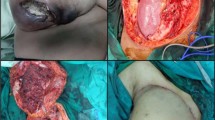Abstract
Purpose
Askin tumors are rare but highly malignant chest wall tumors, which require multimodal therapy including often extensive resection of the thoracic wall. This study evaluated the outcome of Askin tumor in seven patients with an interdisciplinary approach.
Methods
Patients’ records, treated between 1994 and 2011, were reviewed retrospectively. Seven patients (three male, four female; mean age 12.3 years; range 2–21 years) were included. All patients received neoadjuvant chemotherapy. After reduction of initial tumor volume, radical tumor resection and thoracic wall reconstruction were performed. All survivors were evaluated in 2011 by clinical examination and lung function test.
Results
Five-year survival rate in our group of patients is 86 % and overall survival is 71 %. There were two mortalities. One patient passed away 7.5 years after the primary management, mainly attributed to tumor progression, which demanded aggressive surgical procedures and irradiation. Another patient died 18 months after the first diagnosis after several surgical interventions for recurrent multiple pulmonary metastases. Three years after the first diagnosis, one patient suffered from clear cell sarcoma of the contralateral kidney and developed a local recurrence of Askin 1 year later. The large chest wall defects arising after surgery have been successfully reconstructed using combination of latissimus dorsi muscle flaps and biomaterials.
Conclusion
Data of pediatric patients with Askin tumor is scarce. Analysis of our seven patient series indicates that improved outcomes (71 % over all survival rate and 86 % 5-year survival rate) can be achieved by aggressive interdisciplinary management including radical surgery and chemotherapy. Chest wall stability can be achieved by utilization of local muscle flaps and biomaterials to cover surgical chest wall defects.

Similar content being viewed by others
References
van den Berg H, van Rijn RR, Merks JH (2008) Management of tumors of the chest wall in childhood: a review. J Pediatr Hematol Oncol 30(3):214–221
Askin FB, Rosai J, Sibley RK et al (1979) Malignant small cell tumor of the thoracopulmonary region in childhood: a distinctive clinicopathologic entity of uncertain histogenesis. Cancer 43:2438–2451
Khoury JD (2005) Ewing sarcoma family of tumors. Adv Anat Pathol 12(4):212–220
Nakajima Y, Koizumi K, Hirata T et al (2006) Long-term survival of Askin tumor for 10 years with 2 relapses. Ann Thorac Cardiovasc Surg 12:137–140
Ahmad R, Mayol BR, Davis M et al (1999) Extraskeletal Ewing sarcoma. Cancer 85:725–731
Laskar S, Nair C, Mallik S et al (2011) Prognostic factors and outcome in Askin-Rosai tumor: a review of 104 patients. Int J Radiat Oncol Biol Phys 79(1):202–207
Ambros IM, Ambros PF, Strehl S et al (1991) MIC2 is a specific marker for Ewing’s sarcoma and peripheral primitive neuroectodermal tumors. Evidence for a common histogenesis of Ewing’s sarcoma and peripheral primitive neuroectodermal tumors from MIC2 expression and specific chromosome aberration. Cancer 67:1886–1893
Juergens C, Weston C, Lewis I et al (2006) Safety assessment of intensive induction with vincristine, ifosfamide, doxorubicin, and etoposide (VIDE) in the treatment of Ewing tumors in the EURO-E.W.I.N.G. 99 clinical trial. Pediat Blood Cancer 47:22–29
Salzer-Kuntschik M, Delling G, Beron G et al (1983) Morphological grades of regression in osteosarcom after polychemotherapy—study COSS 80. J Cancer Res Clin Oncol 106:21–24
Shamberger RC, LaQuaglia MP, Gebhardt MC et al (2003) Ewing sarcoma/primitive neuroectodermal tumor of the chest wall: impact of initial versus delayed resection on tumor margins, survival, and use of radiation therapy. Ann Surg 238(4):563–567 discussion 567-8
Juergens J, Bier V, Harms D et al (1988) Malignant peripheral neuroectodermal tumors. A retrospective analysis of 42 patients. Cancer 61:349–357
Aurias A, Rimbaut C, Buffe D et al (1984) Translocation involving chromosome 22 in Ewing’s sarcoma: a cytogenetic study of four fresh tumors. Cancer Genet Cytogenet 12:21–25
Whang-Peng J, Triche TJ, Knutsen T et al (1984) Chromosomal translocation in peripheral neuroepithelioma. N Engl J Med 311:584–585
Christiansen S, Semik M, Dockhorn-Dworniczak B et al (2000) Diagnosis, treatment and outcome of patients with Askin-tumors. Thorac Cardiovasc Surg 48:311–315
Ladanyi M, Lewis R, Garin-Chesa P et al (1993) EWS rearrangement in Ewing’s sarcoma and peripheral neuroectodermal tumor molecular detection and correlation with cytogenetic analysis and MIC2 expression. Diagn Mol Pathol 2:141–146
Delattre O, Zucman J, Plougastel B et al (1992) Gene fusion with an ETS DNA-binding domain caused by chromosome translocation in human tumours. Nature 359:162–165
Pizzo PA, Poplack DG (2002) Principles and practice of pediatric oncology. Philadelphia: Lippincott, Williams and Wilkins, pp 973–1016
Trakhtenbrot L, Neumann Y, Mandel M et al (1996) n vitro proliferative advantage of bone marrow cells with tetrasomy 8 in Ewing sarcoma. Cancer Genet Cytogenet 90(2):176–178
Shamberger RC, Laquaglia MP, Krailo MD et al (2000) Ewing sarcoma of the rib: results of an intergroup study with analysis of outcome by timing of resection. J Thorac Cardiovasc Surg 119:1154–1161
Sawin RS, Conrad EU 3rd, Park JR et al (1996) Preresection chemotherapy improves survival for children with Askin tumors. Arch Surg 131(8):877–880
Nesbit ME Jr, Gehan EA, Burgert EO Jr et al (1990) Multimodal therapy for the management of primary, nonmetastatic Ewing’s sarcoma of bone: a long-term follow-up of the first intergroup study. J Clin Oncol 8:1664–1674
Veronesi G, Spaggiari L, Solli PG et al (2003) Preoperative chemotherapy is essential for conservative surgery of Askin tumors. J Thorac Cardiovasc Surg 125:428–429
Gapany C, Raffoul W, Zambelli P et al (2009) Latissimus dorsi muscle-flap over Gore-Tex patch for coverage of large thoracic defects in paediatric Ewing sarcoma. Pediatr Blood Cancer 52:679–681
Applebaum MA, Worch J, Matthay KK et al (2011) Clinical features and outcomes in patients with extraskeletal Ewing sarcoma. Cancer 117(13):3027–3032
Author information
Authors and Affiliations
Corresponding author
Rights and permissions
About this article
Cite this article
Basharkhah, A., Pansy, J., Urban, C. et al. Outcomes after interdisciplinary management of 7 patients with Askin tumor. Pediatr Surg Int 29, 431–436 (2013). https://doi.org/10.1007/s00383-013-3272-1
Accepted:
Published:
Issue Date:
DOI: https://doi.org/10.1007/s00383-013-3272-1




